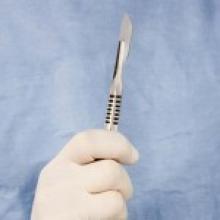User login
This was one of the questions posed by Dr. Michael M. Abecassis, chief of the division of organ transplantation at Chicago’s Northwestern Memorial Hospital, during his Thomas E. Starzl Transplant Surgery State-of-the-Art lecture in Boston over the weekend at the annual meeting of the American Association for the Study of Liver Diseases.
“If we truly believe that living donor death should be a zero event, we should not be doing living donor transplants because it will never be a zero event,” Dr. Abecassis said. Zero events are defined as things “that should never, ever happen, such as operating on the wrong side of a patient,” he said. “In living donor transplantation there are factors much beyond our control that can result in a donor death.” Two recent living donor deaths—one death occurred in late May at the Lahey Clinic in Burlington, Mass., and the other occurred in early August at the University of Colorado Hospital in Aurora—are a testament to this statement.
“Clearly, we just have to accept that donor death will never be a zero event, whether it’s kidney donor or liver donor, and we have to make a decision about what is the right risk threshold,” Dr. Abecassis stated.
In your opinion, what is an acceptable risk threshold? - Diana Mahoney
This was one of the questions posed by Dr. Michael M. Abecassis, chief of the division of organ transplantation at Chicago’s Northwestern Memorial Hospital, during his Thomas E. Starzl Transplant Surgery State-of-the-Art lecture in Boston over the weekend at the annual meeting of the American Association for the Study of Liver Diseases.
“If we truly believe that living donor death should be a zero event, we should not be doing living donor transplants because it will never be a zero event,” Dr. Abecassis said. Zero events are defined as things “that should never, ever happen, such as operating on the wrong side of a patient,” he said. “In living donor transplantation there are factors much beyond our control that can result in a donor death.” Two recent living donor deaths—one death occurred in late May at the Lahey Clinic in Burlington, Mass., and the other occurred in early August at the University of Colorado Hospital in Aurora—are a testament to this statement.
“Clearly, we just have to accept that donor death will never be a zero event, whether it’s kidney donor or liver donor, and we have to make a decision about what is the right risk threshold,” Dr. Abecassis stated.
In your opinion, what is an acceptable risk threshold? - Diana Mahoney
This was one of the questions posed by Dr. Michael M. Abecassis, chief of the division of organ transplantation at Chicago’s Northwestern Memorial Hospital, during his Thomas E. Starzl Transplant Surgery State-of-the-Art lecture in Boston over the weekend at the annual meeting of the American Association for the Study of Liver Diseases.
“If we truly believe that living donor death should be a zero event, we should not be doing living donor transplants because it will never be a zero event,” Dr. Abecassis said. Zero events are defined as things “that should never, ever happen, such as operating on the wrong side of a patient,” he said. “In living donor transplantation there are factors much beyond our control that can result in a donor death.” Two recent living donor deaths—one death occurred in late May at the Lahey Clinic in Burlington, Mass., and the other occurred in early August at the University of Colorado Hospital in Aurora—are a testament to this statement.
“Clearly, we just have to accept that donor death will never be a zero event, whether it’s kidney donor or liver donor, and we have to make a decision about what is the right risk threshold,” Dr. Abecassis stated.
In your opinion, what is an acceptable risk threshold? - Diana Mahoney
